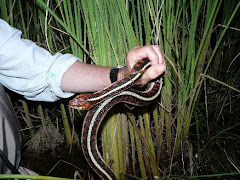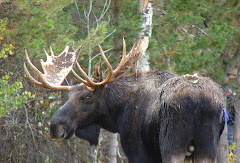A little background....These ponds were created when the park was still ranchland and the dam that created them was left in place when it was discovered that, even though artificial, the ponds were great habitat for many aquatic species. It's well documented in the scientific literature that bullfrogs outcompete and displace red-legged frogs and are a major cause of their decline, resulting in them being listed as threatened under the Endangered Species Act. For the past six years, researchers have been catching, PIT-tagging and releasing both bullfrogs and red-legs at these ponds and keeping track of reproduction and overall numbers of both species, in an effort to document the pervasive takeover by the bullfrogs and the eventual loss of the red-leg population.
At first, even though there were far fewer red-legs than bullfrogs, it seemed the red-legs were holding their own and it was thought, "hey, maybe they can co-exist. However, in the last few years it's become obvious that the red-legs are losing.... no recruitment (no little frogs making it to adulthood) and now we're losing the adults. So, the focus has shifted from catch and release to culling all the bullfrogs we can catch to see how quickly the red-leg population can bounce back, if at all. Wish them luck; they're going to need it.




Conditions can skunk you though. Last night was warm enough so that the frogs, having absorbed all that wonderful solar energy during the day, and sitting in the bathtub-warm pond, were extremely active and extremely skittish. We couldn't get within ten feet of them before they would duck back under water and torpedo off. We caught one red-leg (well, two actually, but in a total rookie move I dropped it) and one bullfrog. The ten-year-old among us caught the only bullfrog of the evening.

"WHOA!"
 The bullfrogs I've seen here at Coe are the largest I've seen anywhere in the greater SF bay area. They look mutated. These stockponds are so warm and so productive that the normal two-year life cycle of the bullfrog can be completed in only one year, which makes it that much tougher on the red-legs. This big male was almost 9 inches long from the tip of his nose to the vent (urogenital opening). If you stretched him out, he'd have easily been over a foot long from toe to toe. Contrast that with the measurement of the red-leg male, who was about 4-1/2" snout-vent length. Any wonder why bullfrogs are decimating red-legs? Look no further for your evidence.
The bullfrogs I've seen here at Coe are the largest I've seen anywhere in the greater SF bay area. They look mutated. These stockponds are so warm and so productive that the normal two-year life cycle of the bullfrog can be completed in only one year, which makes it that much tougher on the red-legs. This big male was almost 9 inches long from the tip of his nose to the vent (urogenital opening). If you stretched him out, he'd have easily been over a foot long from toe to toe. Contrast that with the measurement of the red-leg male, who was about 4-1/2" snout-vent length. Any wonder why bullfrogs are decimating red-legs? Look no further for your evidence.California red-legs do have one thing working for them: they are adapted to seasonal ponds and are better able to handle dry conditions than bullfrogs, so we had hoped that the upper pond would dry up also, but it's not looking like that is going to happen this year. So, we'll keep monitoring these ponds, as well as other ponds in other areas, including the Santa Cruz coast. Doing what we can to keep the sun from setting on these incredible little amphibians.









No comments:
Post a Comment